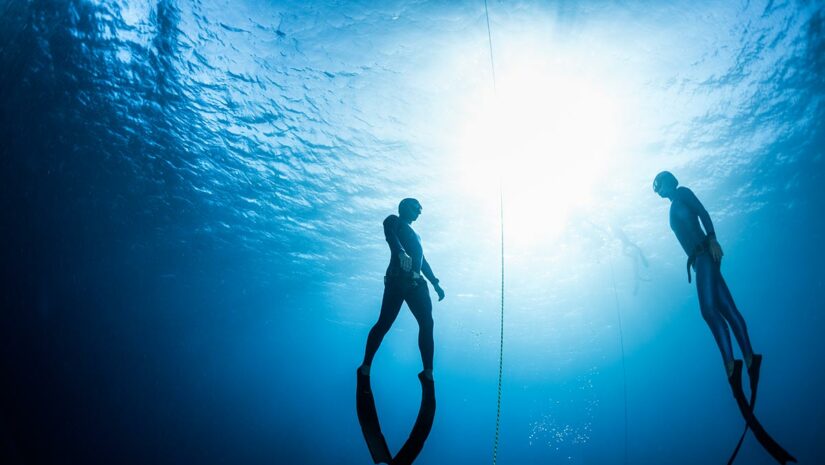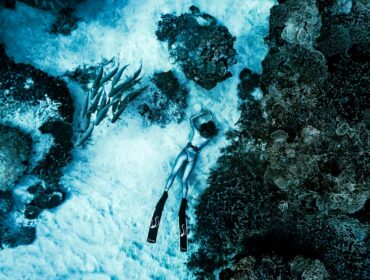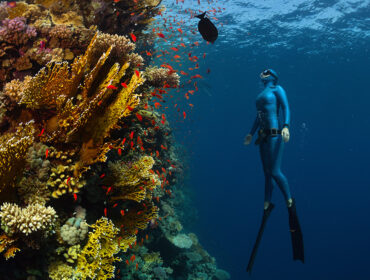You have most likely seen videos and images of freediving. For many people, freedivers who can hold their breath for several minutes and can dive down to the depths of the ocean might seem like super humans. But the truth is, freediving is a sport, and like all sports, it requires skills and practice. Don’t forget, those “superhuman” freedivers were once beginners too. As a beginner freediver, how do you start? Follow our beginner’s guide to freediving to begin.
- What is freediving?
- What do you need to know before freediving?
- Freediving health and safety rules
- Freediving equipment
- Types of freediving
What is freediving?
Freediving is the practice of holding one’s breath while underwater. With that being understood, it’s likely you already have some sort of experience with freediving. Whether it was seeing how long you can be underwater in your bathtub or trying to pick up a coin from the bottom of a swimming pool, you have already tried freediving!
Why should you try freediving?
The fact that we all have instinctively held our breath and submerged ourselves in water already shows our natural draw towards the depths. Learning to freedive gives us the tools to extend these blissful moments, to leave our natural element and immerse ourselves in a new one.
Much of freediving goes against our natural instincts. So, embarking on the journey of becoming a freediver is a journey into our own nature and abilities as an individual. We are confronted with fear, we can feel overwhelmed and frustrated, but along the way we also get to experience moving through space in all three dimensions. Freediving can make you feel empowered by overcoming fears, and you can learn to be at peace in a situation that once perhaps caused anxiety.
What you get out of freediving depends on how seriously you want to take it. At minimum, you will learn to experience the underwater world in a new way. At the other end of the scale, you can use freediving as a tool for self-discovery; just the same as one may find with yoga or martial arts.

What do you need to know before freediving?
Breathing
Freediving is the act of holding the breath, so it may not be surprising how important breathing is to freediving. In a freediving course, you will learn how to take a full breath, completely utilizing your total lung volume. You will also learn how to use the breath to calm your mind and lower your heart rate. Finally, you will learn the best way to re-oxygenate your body after a breath hold.
Equalizing
What is equalizing and why is it important?
Did you ever dive to the bottom of a pool and feel some pressure or pain in your ears? That is the feeling of the weight of the water above you. It is compressing the air in your middle ear and stretching your ear drum. Experiencing this at six feet (two meters) can make diving any deeper seem impossible, or at least very painful.
Well, luckily for us, our body is able to “equalize” this pressure. We have a small passageway leading to the middle ear called the eustachian tube. This tube allows air to leave or enter the middle ear to protect the eardrum. Sometimes this can happen passively, for example when you are driving on a mountain road you may feel some pressure in your ears, only for it to release soon afterwards.
In freediving and scuba diving, we must actively equalize the pressure in our ears. We do this by creating pressure in our nasal cavity (where the eustachian tube begins). This pressure travels through the tube and into our middle ear. You can experience this now by pinching your nose and gently trying to exhale through the nose. The pressure has nowhere to go except into the middle ear, and you should feel a pop — like you experience when on an airplane. We must do this every three feet (one meter) when descending.
If we equalize at this rate, we will never feel even the slightest discomfort in our ears while freediving. The need to equalize so regularly is without a doubt the most foreign thing about freediving. But with practice and a good teacher, it will soon become second nature.

General freediving health and safety rules
When done responsibly, freediving is one of the safest sports that you can do. That being said, there are, of course, some inherent risks. Before beginning your course, you will be required to fill out a medical statement to ensure you don’t have any pre-existing health issues. So assuming you are in good health, what could make freediving dangerous?
Black out
The most apparent risk is the fact that we are, after all, holding our breath. The body has an astonishing ability to conserve oxygen, but the fact we are no longer breathing means there is a limited store.
What happens if we run out of oxygen?
Long before we run out of oxygen, we will lose consciousness. This is what we call a black out (BO). This is a kind of survival mechanism to conserve what’s left of the oxygen in our body. This loss of consciousness happens when there is still enough oxygen left to keep the brain oxygenated for a number of minutes. This is the reason freedivers can hold their breath and even BO without suffering from any brain damage.
Alone, an underwater BO will most likely be fatal. So the cardinal rule in freediving is to never freedive alone. Always dive with a buddy. As part of any freediving course, you will learn how to work as a safety pair and rescue a diver from BO. BO is not common at all and should only happen if a diver has been very reckless. However, we must always be conscious and ready to act if necessary.
Above all, the “never freedive alone” rule is paramount. Dive with a professional or a trained partner to avoid and mitigate any possible risk.
Weighting
In freediving (as in scuba), we use lead weight to counter the buoyancy created by our wetsuit. As we go deeper we become less buoyant, until the point where we are actually sinking. A common mistake and safety issue is to wear too much weight. Wearing too much weight makes going to depth easier, but returning to the surface and staying on the surface becomes more challenging.
In freediving, we like to be able to float on the surface without any effort and be positively buoyant for at least the first 30 feet (10 meters). This means we are able to relax on the surface before our dive and it makes things much easier should we need to perform a rescue or be rescued.
Slow progression
A common question that instructors get asked by non-freedivers is “what do you do if you feel like you need to breathe at the bottom?” This is a good question. The answer is: “I know that I won’t”. Why? Because as you become a more experienced freediver, you build confidence and experience with each depth before going deeper. Once you are confident with that depth, you will only add about six feet (less than two meters) and start the process again. Each time we dive, we already know how deep we will go and how long it will take. This way, there are no surprises, and we can be confident that we can do the dive safely and pleasantly.

What equipment do you need to freedive?
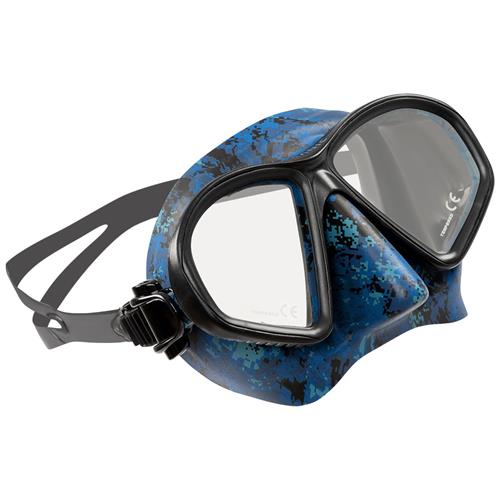
Mask
One of the most exciting things about freediving is that it opens up a whole new world to explore. To be able to do this, we will of course need to see! This is why we use a mask. We use a mask instead of swimming goggles, so we can equalize the pressure as we descend (just like we need to equalize our ears). Did you ever dive to the bottom of a pool and feel your goggles suck into your eyes? We can prevent this with the mask by exhaling some air through the nose to release this sucking effect. Freediving masks are typically low-volume, so we don’t need to waste too much air to release this pressure (as we would with a mask with higher volume). The mask above is the Oceanic Predator Mask.
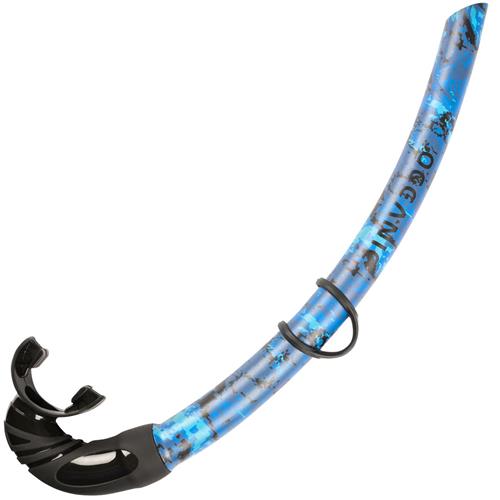
Snorkel
A snorkel allows us to breathe while face-down in the water. You will need to catch your breath after a dive and prepare for the next one. The snorkel allows us to do this in the most relaxed way. Some people can struggle with breathing through the mouth at first, but quickly get used to it. The snorkel above is the Oceanic Predator Snorkel.
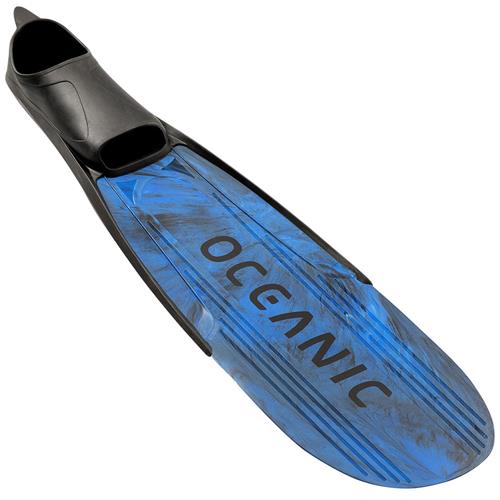
Fins
You may have noticed that freediving fins are much longer than scuba diving fins. The reason is scuba divers are generally not in much of a hurry as they have about 60 minutes of air on their back. Freedivers, on the other hand, need to be more efficient. Hence, we have larger and more powerful fins. There is definitely technique and strength needed to use these fins correctly. You will learn how to use them in any beginner freediving course. The fins above are the Oceanic Predator Fins 7/7.5.
Suits
Open water is often cold. To allow us to spend more time in the water, we wear a wetsuit. Wetsuits are made of neoprene. The thicker the neoprene, the warmer the suit. The downside of wearing a wetsuit is that the thicker it is, the less freedom of movement you have, and the more buoyant you become. Hence, the need for weights.
Weights
As discussed earlier, adding weight helps to compensate for the extra buoyancy of a wetsuit. It is, however, important to remember that weight is a double-edged sword. Not enough and it will be too difficult to get down. Too much and it will be too difficult to get back to the surface. You will be shown how to properly weight yourself as part of any beginner freediving course.

What are the different types of freediving?
To freedive is to spend time underwater while holding your breath. So as you can imagine, there are lots of ways to enjoy freediving, and many different motivations to do it.
Exploration
For many people, freediving is a great way to explore and observe nature. It is more active and stimulating than scuba diving, and with some training you can easily reach the same depths as a recreational scuba diver. Observing the underwater world from the surface and then diving down to explore gives you the feeling of flying and soaring around like an eagle. Once you learn to move smoothly and efficiently, you will be able to interact with all kinds of marine life who are very curious to check out this strange new visitor to their world.
Line diving
Diving on the line is how we train to go deeper and improve our freediving skills. This type of freediving is much more about our internal journey, rather than exploration or spearfishing. The idea is to train and get deeper, this is what we think of when we think of freediving as a sport. Within line diving there are six subcategories, each with its own set of skills to master. There are also competitions where freedivers can compete in four of these subcategories.
The competition freediving subcategories are:
- Constant Weight: Swimming down and up with a monofin.
- Constant Weight Bifins: Swimming down and up with bifins
- Free Immersion: Pulling down and up using a rope.
- Constant Weight No Fins: Swimming down and up using only your arms and legs.
The non competition freediving subcategories are:
- Variable Weight: Descend using a weighted “sled” and ascend under your own power.
- No Limits: Descend using a weighted sled and ascend using a lift bag.
Spearfishing
Spearfishing is both a sport and hobby that is growing in popularity. It is the combination of hunting and freediving, and is likely the most ethical and sustainable way to fish. A spearfisher stalks fish in their own element, while holding his/her breath — you can’t be fairer than that! To become a spearfisher, you must not only be a trained freediver, but you must also understand how to set up your speargun and other equipment, be able to recognize the different species of fish, and know how to stalk each species.
Pool diving
This type of freediving is done solely in the pool. Different pool freediving disciplines include holding the breath for as long as possible while stationary (static apnea) and also distance covered (dynamic apnea). As most freedivers don’t always have access to depth, the pool is a good way to maintain certain freediving skills, so they can be prepared next time they can try deep diving. Pool diving has its own specialists, with athletes who can hold their breath for longer than 10 minutes and swim more than 300m in a single breath!
Freediving for Beginners
Anyone can learn to freedive. Like any sport, some people will have more natural talent than others, but everyone can get better at spending time below the water. If you want to give freediving a try, then simply contact your local freediving instructor or center and arrange a freediving course.

